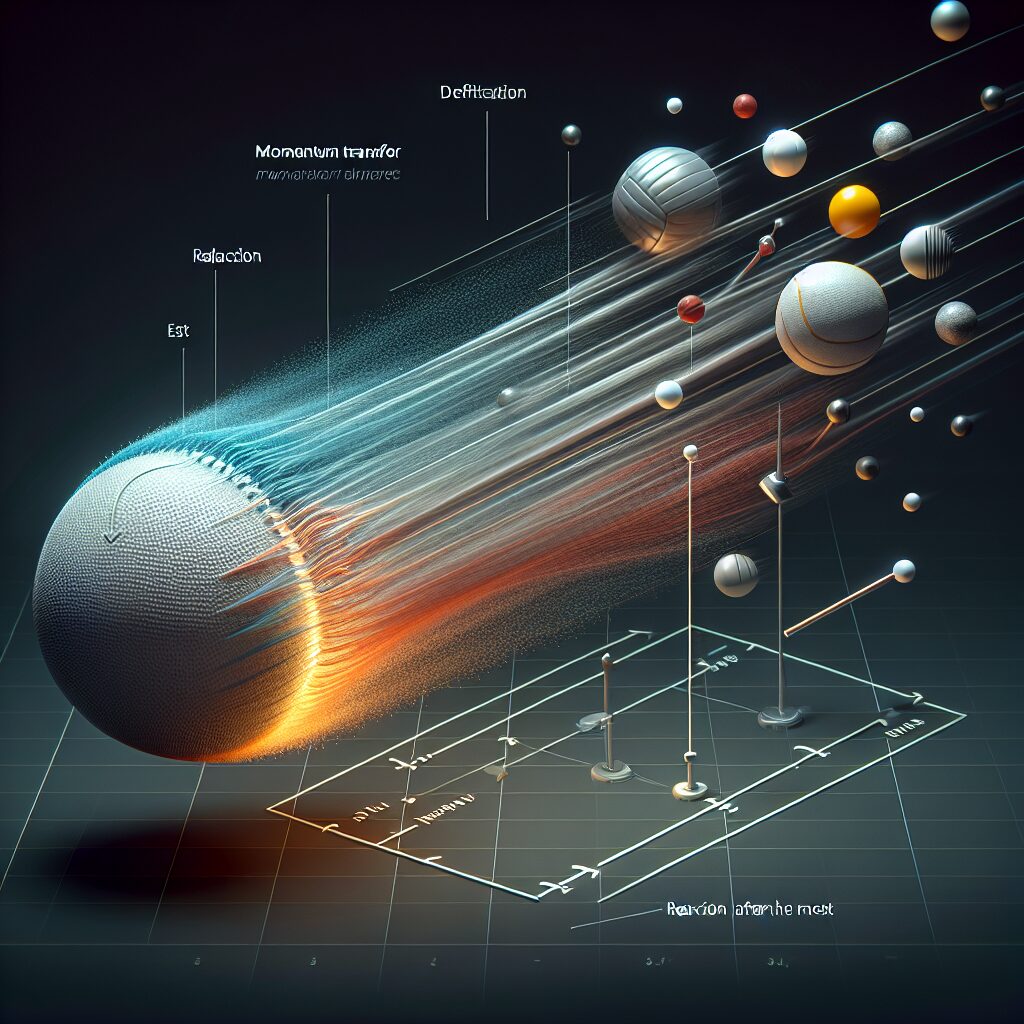Momentum Transfer: The Science of Ball Impact is a fascinating field of study that delves into the intricate mechanics of how objects collide and interact in motion. At its core, momentum transfer refers to the exchange of momentum between two objects during a collision or impact. This exchange of momentum plays a crucial role in various areas such as sports, engineering, and even automotive safety.
When it comes to specific impacts, the science of ball impact uncovers a multitude of intriguing facets. For instance, researchers have discovered that the coefficient of restitution (COR), which measures the elasticity of a ball, has a significant impact on the outcome of a collision. Balls with higher COR values tend to rebound more energetically, while those with lower values exhibit less bounce. This has profound implications in sports like tennis and golf, where players rely on the rebound of the ball to achieve optimal performance.
Moving forward, let’s explore some key takeaways from the study of momentum transfer and ball impact. By understanding the principles behind the exchange of momentum, we can gain insights into enhancing athletic performance, designing more efficient vehicles, and even developing safety measures to protect individuals from the impact of accidents. So, let’s delve deeper into the fascinating world of momentum transfer and uncover the hidden dynamics behind every ball collision.
Key Takeaways
1. Momentum transfer is crucial in understanding the science behind ball impact, as it helps explain the forces involved and how they affect the motion of the ball.
2. During a collision between a ball and another object, momentum is transferred between the two, with the ball gaining or losing momentum depending on the object it collides with.
3. The coefficient of restitution (COR) is a key factor in determining how much momentum is transferred during a collision. It measures the elasticity of the collision and influences the speed and direction of the ball after impact.
4. The type of material and its properties also play a significant role in determining the amount of momentum transfer. Softer materials, for example, tend to absorb more energy and reduce the rebound speed of the ball.
5. Understanding the science of ball impact is not only important in sports like tennis or golf, but it also has practical applications in various fields, such as engineering, materials science, and product design.
What is the Science behind Momentum Transfer in Ball Impact?
The Basics of Momentum Transfer
When a ball collides with another object, such as a bat or racket, the concept of momentum transfer comes into play. Momentum is defined as the product of an object’s mass and velocity. When two objects collide, the momentum of the first object is transferred to the second object, resulting in a change in its motion.
Factors Affecting Momentum Transfer
Several factors influence the transfer of momentum during a ball impact:
- Mass: The mass of the ball and the object it collides with play a crucial role in determining the amount of momentum transferred. A heavier ball or object will transfer more momentum.
- Velocity: The velocity at which the ball and the object are moving also affects momentum transfer. Higher velocity results in greater momentum transfer.
- Collision Duration: The time it takes for the ball and the object to come into contact and separate also impacts momentum transfer. A longer collision duration leads to increased momentum transfer.
- Elasticity: The elasticity of the objects involved in the collision influences the transfer of momentum. In elastic collisions, where kinetic energy is conserved, momentum transfer is maximized.
Applications of Momentum Transfer in Sports
Momentum transfer is of great importance in various sports, where the impact between a ball and a sporting equipment or surface greatly affects the game. Here are some examples:
Tennis
In tennis, the transfer of momentum from the player’s racket to the ball determines the speed and direction of the shot. Players utilize techniques to optimize momentum transfer, such as timing their swings and hitting the ball at the sweet spot of the racket.
Golf
In golf, the collision between the clubface and the ball is instrumental in achieving distance and accuracy. Understanding momentum transfer helps golfers optimize their swing mechanics and choose the right club for specific shots.
Baseball
During a baseball pitch, the transfer of momentum from the pitcher’s arm to the ball impacts its speed and trajectory. Pitchers use various techniques to enhance momentum transfer, such as leg drive and arm extension, to generate maximum velocity.
Soccer/Football
The interaction between the foot and the ball in soccer or football provides an opportunity to optimize momentum transfer for powerful shots and accurate passes. Players work on techniques like striking the ball with the appropriate surface of the foot to enhance momentum transfer.
Tips for Maximizing Momentum Transfer
- Choose the right equipment: Selecting the right ball and sporting equipment with suitable characteristics, such as weight and elasticity, can enhance momentum transfer.
- Focus on technique: Proper technique and body mechanics play a crucial role in optimizing momentum transfer. Seek guidance from coaches or experts to improve your skills.
- Timing and coordination: Understanding the timing and coordination required for a successful impact can help maximize momentum transfer. Practice drills that focus on these aspects of the game.
- Consistency: Developing consistency in your movements and strikes will lead to more efficient momentum transfer over time. Regular practice and repetition can help achieve this consistency.
- Analyze and adjust: Continuously analyze your ball impacts and seek feedback to identify areas for improvement. Make necessary adjustments to enhance momentum transfer and overall performance.
Frequently Asked Questions
1. What is momentum transfer in the context of ball impact?
Momentum transfer refers to the transfer of momentum from one object to another during a collision. In the case of ball impact, it is the transfer of momentum from the ball to the object it hits.
2. How does momentum affect the outcome of a ball impact?
Momentum plays a crucial role in determining the outcome of a ball impact. The amount of momentum transferred to the object depends on factors such as the mass and velocity of the ball, and the elasticity of the collision. This transfer of momentum affects the motion and behavior of both the ball and the object it strikes.
3. What factors influence momentum transfer in ball impact?
Several factors influence momentum transfer during ball impact. These include the mass and velocity of the ball, the angle and direction of impact, the elasticity of the collision, and the surface properties of both the ball and the object that it hits.
4. How is momentum transfer measured in ball impact?
Momentum transfer in ball impact is often measured using principles of physics, specifically through the calculation of momentum before and after the collision. This can be done using formulas that relate to the conservation of momentum.
5. What are the practical applications of understanding momentum transfer in ball impact?
Understanding momentum transfer in ball impact has numerous practical applications. It helps engineers design safer sports equipment, such as helmets or protective gear, by analyzing the impact forces involved. It also aids in optimizing sports techniques and improving performance, as athletes can better understand and control the transfer of momentum during ball contact.
6. How does the elasticity of the collision affect momentum transfer?
The elasticity of the collision directly affects the momentum transfer during ball impact. In a perfectly elastic collision, where there is no loss of kinetic energy, the momentum transfer is maximized. In contrast, in an inelastic collision, where kinetic energy is not conserved, the momentum transfer may be reduced.
7. Can momentum transfer be manipulated or controlled?
While momentum transfer is subject to the laws of physics, it can be influenced and controlled to some extent. By adjusting factors such as the angle of impact, the ball’s velocity, or the surface properties of the objects involved, it is possible to manipulate the amount and direction of momentum transfer in ball impact.
8. Are there any safety concerns associated with high momentum transfer in ball impact?
High momentum transfer can lead to increased impact forces, which may pose safety concerns in certain situations. For example, in contact sports like football or hockey, excessive momentum transfer can result in more severe injuries. Understanding and managing momentum transfer is essential in minimizing such risks and ensuring the safety of athletes.
9. Does the type of ball used affect momentum transfer in ball impact?
Yes, the type of ball used can significantly impact momentum transfer. Different ball materials, densities, and textures can influence how momentum is transferred during impact, altering factors such as the rebound velocity or the spin induced. These variations play a role in the overall performance and characteristics of the ball.
10. How does momentum transfer apply to other sports or real-life scenarios?
Momentum transfer applies to various sports and real-life scenarios. In sports such as golf, tennis, or baseball, understanding momentum transfer is crucial for optimizing the player’s skills and achieving desirable outcomes. Beyond sports, momentum transfer principles are relevant in car accidents, engineering designs, and even everyday activities like throwing or catching objects.
Final Thoughts
Understanding the science behind momentum transfer in ball impact can provide valuable insights into the mechanics of sports, as well as other real-life scenarios. By comprehending how momentum is transferred during collisions, athletes can enhance their performance and minimize the risk of injuries. Engineers, too, can leverage this knowledge to design safer equipment and improve overall product functionality.
Moreover, studying momentum transfer fosters a deeper appreciation for the role of physics in our lives. From the force exerted by a golf swing to the accuracy of a basketball shot, the laws governing momentum transfer contribute to the excitement and precision of various activities. So, whether you’re an athlete striving for excellence or simply intrigued by the physics of motion, exploring the science of ball impact and momentum transfer opens up a fascinating realm of understanding.




